Today’s post is a guest write-up by Hory Mukerjee. Hory is a travel enthusiast and works with Infosys. He has authored a book, loves to read, write and travel. His father being from the Armed forces, he had the opportunity to travel through the length and breadth of the country. Here is Hory’s take on Ooty.
Text by Hory Mikerjee. Pictures from paintedstork.com
Ooty, the queen of hill stations, has been a popular tourist destinations for years. However, it fails in living up to its name. I was majorly disappointed with my visit to Ooty this summer.
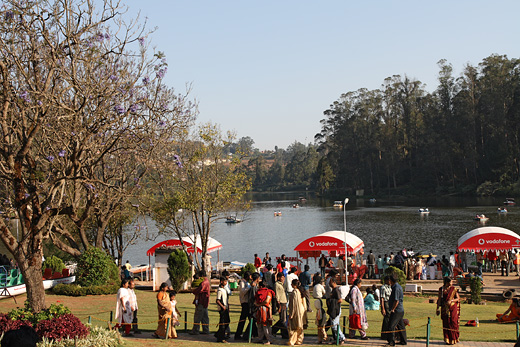
Ooty attracts a lot of people in peak summer season. Hotels were in a mess and were very crowded. The commercial junction of ooty (charing cross) looked more like a busy street in Mumbai or Bangalore, the only difference being the hills surrounding the town. There are many hotels, but finding a good one is always a big question mark. A quick search in the town may show up just a handful of good places, and the rates are never a good value for money. However, there is no dearth of rooms and it is not hard to find a place without advance bookings. Tamil Nadu tourism provides a list of homestays, and it would be a good idea to check them out if you are looking for some local flavour.
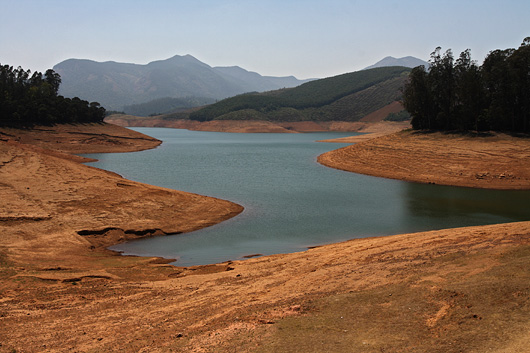
The places for sightseeing around Ooty disappointed me majorly, all of them being highly commercialized. The beauty of nature can be experienced within oneself if a place is serene or calm. But none of the places I visited kept up to the great praises I had heard earlier. All tourist points were flooded with people, or had become dump yards for garbage. The ooty lake, a place much spoken of, is also commercialized. However, a ride on the small toy train beside the lake wasn’t very disappointing. It was much better than the boat ride.
The rose garden is another beautiful place with a variety of flowers. One gets mesmerized and intoxicated with the fragrance of roses. It is a paradise for photographers too. Another good place to visit is the St. Stephens’s church in the middle of the city, which does not attract many visitors. The wall decors of the church are worth a mention.
Another spot that I enjoyed thoroughly was the tea factory in ooty. The manufacturing unit was running when I visited, and it was a good learning for a curious tea lover that I am. You also get to buy good quality tea and chocolates from here. Another place to look for excellent chocolates and fudges is the Kingston bakery at the charring cross.
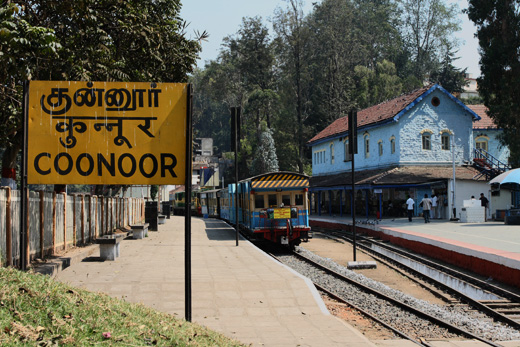
A day of trip to Pykara falls, Mukurthi National Park, Avalanche, fifth mile and ninth mile is not very disappointing either. Pykara falls is a treat for photographers.
The journey to ooty would be incomplete without a toy train ride from the ooty station. The ride is amazing, as the train runs through picturesque valleys. There is a long queue in the station for tickets, so it is always better to buy in advance through irctc.
Though Ooty is a big disappointment, it still holds a charm. It is a good, quick gateway from Bangalore. However, if you are looking up to stay in proximity to nature and away from the hustle bustle, Coonoor (16 kms from ooty) is a better option than Ooty.
Rohtang Pass is a place that marks many divides. To the south are the green slopes caressed by monsoons every year and to its north is a stark landscape often called the forbidden valley. Beyond Rohtang, the landscape begins to start resembling Tibetan, and so do the people. Temples give way to monasteries and Shiva makes way for Buddha. Apple orchards are replaced by potato and sweet peas. It is as if you just changed the DVD and a different movie started playing on the gigantic 16:9 screen.
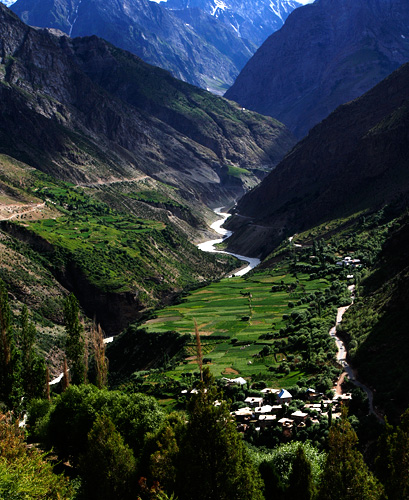
The fabulous setting of the town of Keylonw, Bhaga River and the road from Tandi
People north of Rohtang have an unusual pride about the altitude they live in. Every village along the way lays some special claims about its location. In Spiti Valley, a deviation on the Leh highway, people at Kibber Village once loved to call it as the highest permanent inhabitation in the world. When the record was broken somewhere else, they were not ready to give up. They came up with more possibilities instead: highest village with electricity, highest village with a motorable road, highest village with a post-office, and so on. A quick web search reveals all possible versions and may even give ideas to cook up new ones. Just below Kibber at the base of Spiti Valley, the petrol pump in Kaza doesn’t fall behind in making the ‘highest in the world’ claim.
Going past Keylong, probably every named place has something highest attached to it. It is only a matter of finding out highest ‘what’!? Indian Army takes bulk of the credits for creating all these highest hypes. In Pang, a tourist stopover on the way to Leh, is an army camp labeled as the “world’s highest transit camp.” Far north in Ladakh is Siachin glacier with its notorious claim for being the world’s highest battle field, where India and Pakistan have been fighting and wasting away lives and resources for a land that neither party can put to any good use. Once you have the privilege of making claims for world’s highest battlefield, the highest airfield is obviously not going to be far away. And Khardung-la, the world’s highest motorable pass doesn’t need any introductions. But Khardung-la’s days are probably numbered: everyone speaks of motorable passes in Ladakh and Tibet that raise much higher. I am sure they will find a new title for Khardung la when another pass officially becomes the highest motorable road.
That’s much digression from Rohtang Pass where we started from. It is a quick and steep descent from the pass, down to the valley of Chandra River. The small village of Khoksar next to the river is more a food court than a village. Dhabas line up the 100m or so length of the road, which is as long that the village spreads. A Himachal Pradesh Government PWD bungalow in the village may be open for visitors, but most people prefer to continue to Keylong. Despite the charm of Chandra River, Khoksar is not a pretty place and is too close to Manali for a halt.
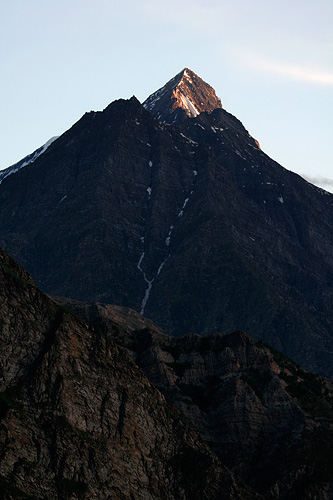
Mighty mountain peaks seen from Keylong town
The way further is parallel to Chandra River, going downstream after crossing the river at Khoksar. It is usually muddy and flows swiftly in the months of July and August – the peak season for travelling to Ladakh. Photographs taken in later months show it in a deep hues of blue, a color that eludes most people who are on their way to Ladakh. The tall peaks along the way tend to have last snow of the season, and many tall waterfalls come down from the steep hills to merge with Chandra.
Tandi, 10km before Keylong has the last petrol pump on the highway. The road here turns right and continues along the valley of Bhaga River. A sign at the confluence of Chandra and Bhaga reads [not verbatim; recreated from memory]: “Welcome to Tandi, the confluence of blue waters of Chandra and green waters of Bhaga.” Unfortunately, the colours are all mixed up with plenty of earth, and what is there to see is two muddy currents coming together into one.
Chandra and Bhaga have an interesting origin. They both begin at different faces of the mountain at the same location – Baralach la. Chandra flows east and then turns west traversing through the valley of Lahaul, while Bhaga flows south through Darcha and Keylong. They meet again in Tandi, like two long lost sisters getting to see and hug each other. More like we see siblings separated at birth rejoining in an emotional drama in a Kannada movie, with the lead actor playing two roles.
Keylong is a quick 20 minutes drive upstream Bhaga River. It is the place where most people prefer to spend the night on the way to Leh, as we found out on arrival.
continued from part – I
The days at Binsar went quickly, as we did things after things, went to places after places, and when we were doing neither, stuffed ourselves to no end.
The valley where our Club Mahindra Resort was located was ideal for short aimless strolls in pine forests. We used it well. The excesses of our enthusiasm was evident when we woke up and assembled at 5 in the morning to gallivant and explore the woods. The reward – silence and fresh air of the morning, views of snow clad peak of Trishul far away, and a chance to see the dense bird population in action. Trishul, giving a dull milky appearance first that soon grows crimson in the early dawn and then to bright white. Blue magpies with their long tails, treepies with their slender bodies, scarlet minivets in dazzling orange and warblers moving swiftly from shrub to shrub. The morning walk, ending with a deliberate detour on the way back that makes us wade a stream, climb barricades and struggle through a fence to find our way back.
On the first day, the long drive to Jageshwar’s ancient temple seemed monotonous and put us to sleep. The pine trees and blue skies never seemed to end. But just when we were about to reach our destination, deodars wrested the mountains from the grip of pines. That meant thick forests, greener and cooler surroundings, a pleasing atmosphere, streams gurgling in the valley and a carpet of fresh grass on the ground. Suddenly rising now and then amidst the trees are small shrines that have stood the test of time and have probably remained there from a time much before the trees that surround them.

Jageshwar is a small village surrounded by thick deodar forest. The mud and cement houses of the village look old and worn out. Their wooden no-frills doors are painted in deep blue or red, giving a feel of a time that rest of the world has left behind.
The long drive to Jageshwar means the temple itself gets deprioritised for a cup of strong tea followed by loo break. The tea is cooked on burning wood and tastes good. But when I order for another, he makes it on LPG, citing that it will be quicker. This one doesn’t taste half as good.

An inquiry with the chai-shop owner for a guide to show us around the temple did not result in a positive response. Unlike in much visited historical locations in the plains, there are no ASI-trained guides here to tell us of the past of the locale and the build of the temples. We fall back on poorly written brochures from tourism department that describe the place in length without actually saying anything.
The temple complex is small but the structures are very impressive. There are about 125 shrines with an enclosure almost an acre in area, varying from 4 feet to 40 feet in height. Some of them are nothing more than small hollow towers with a few inches high lingam hosted in them. The elaborate ones – just a few of them – have the idols of Jageshwar, Mahamritunjaya and Pushti Devi. The towers follow Rekhanagar architecture, with four sides gently tapering as they go up, ending in a gooseberry like crown. Built by Katyuri kings as early as 8th century, Jageshwar is also speculated to be one of the twelve Jyotirlingas.
Just besides the main temple complex is another shrine dedicated to Kubera. Asking the priest to get more information on the carvings turned futile. To my question about a three-headed statue on the wall he replied in an uninterested tone – ‘that too maybe Kubera.’
Besides the beautiful temple complex, the location is scenic and serene, with a stream flowing by and deodar trees surrounding it. But unfortunately it is also infested with priests who do all that they can to catch your attention and not letting you spend your time in peace. But on the way back from there is Dandeshwar Temple, another similar but smaller complex and without the pilgrim appeal of Jyotirlinga, and allowing us to take our time exploring its domain.

There was much to do at the resort when we were not out sightseeing. The ping pong table and the small cricket pitch kept us busy, helping burn all the extra calories we added up in the restaurant. The delicious food was hard to resist. The menu usually looked like ordinary, normal Indian fair, but almost always hard to resist once begun. A fried okra dish and Malpuas remain my favourite to date and have been coming to me in dreams.
The next morning we drove to Binsar Wildlife Sanctuary, an hour away. There is a remarkable change in vegetation as we enter the sanctuary, with pine forest giving way to a variety of thick trees. A dense population of rhododendron trees makes me wonder how colorful this place can be in summers. An inquiry with our driver confirms it – ‘it will be full of flowers in April/May,’ he says. The road ends a kilometer short of zero point – the highest point in the sanctuary, as well in the entire district of Almora. We are here pretty late in the day, but weather gods have been kind on us and we can still see a wide panorama of snowy peaks comprising Nanda Devi, Panchachuli and Trishul.
A few tourists walk in with a guide as we sit and relish on the views. I overhear the guide speak – ‘the tallest of the mountains that you see is Nanda Devi. It is 30km as the crow flies, but 300 by road’. He is a well-informed person and patiently helps us identify the peaks.
We go camping in the forest near the resort the next evening. It is a sort of pampered camping, not my kind of stuff. There are three young men accompanying us and attending to us all the time, pitching the tent for us, serving us food and keeping us comfortable.

Before I know, our days at Binsar are over and we are already heading back. The long journey back to Kathgodam, and then to Delhi and then Bangalore is filled with memories of days well spent in Kumaon’s mountains.
Binsar Information
Binsar Wildlife Sanctuary is 30 minutes drive from Almora. Places to see includes the zero point – the highest point in Almora district with panoramic views of the snow peaks. Seventh century Jageshwar temple is worth visiting. The lakes of Nainital, Bhimtal, Sattal and Naukuchiatal fall on the way to Binsar and are worth a detour.
The Club Mahindra property where we were invited is located 11km from Binsar on Almora-Bageshwar road. It’s in a relatively isolated valley surrounded by small villages on one side and pine forest on the other. The resort has a good campus, comfortable and spacious rooms, food that makes you drool, but lacks a swimming pool. The staff are friendly and attentive and make you feel at home.
![http://travel.paintedstork.com/blog/image/oct08/club_mahindra.jpg]()








